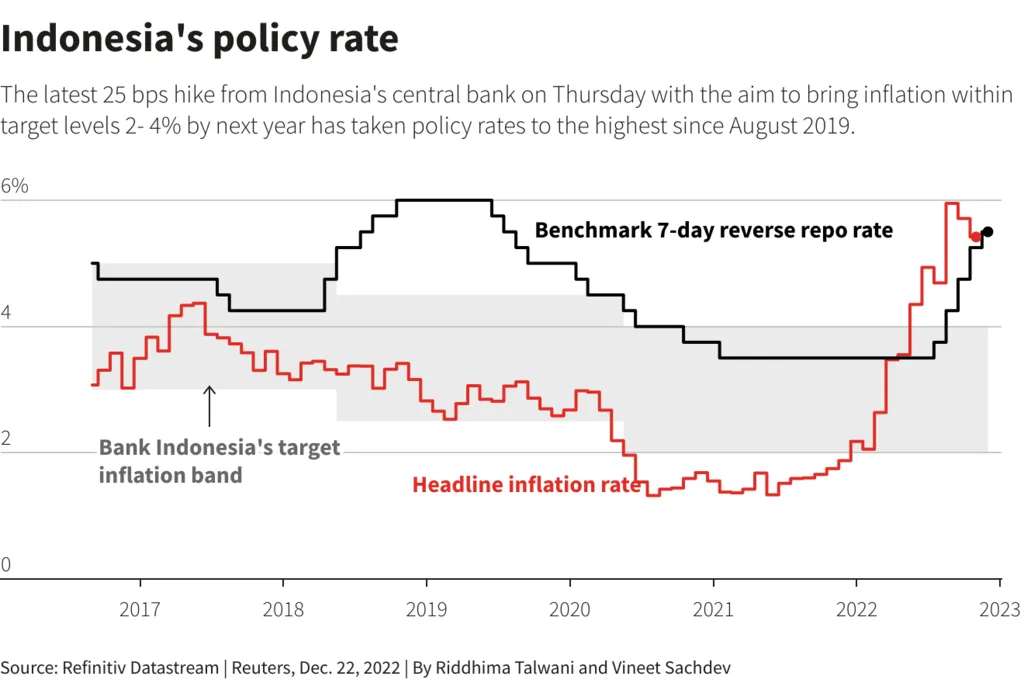Bank Indonesia (BI) decided to maintain its benchmark interest rate at 5.5% during the June 2025 policy meeting, marking a strategic Indonesia Interest Rate Pause following a 25 basis points cut in May. This move aligns with market expectations and highlights BI’s balanced approach to supporting economic growth while keeping inflation in check.
Inflation Moderation Supports Indonesia Interest Rate Pause

A major factor behind the Indonesia Interest Rate Pause is the easing of inflationary pressures. In May 2025, inflation dropped to 1.60%, down from 1.95% in April, comfortably within BI’s target range of 1.5% to 3.5%. This moderation signals that price pressures are under control, reducing the immediate need for further tightening.
The central bank’s inflation target of 2.5% ± 1% for both 2025 and 2026 shows its commitment to price stability, even as external uncertainties loom. The current inflation trend provides BI with the confidence to maintain rates while closely monitoring future developments.
Stable Rupiah and Steady Growth Outlook
Currency stability further reinforced BI’s decision. The Rupiah strengthened by 0.06% against the US dollar between May and June 2025. It also appreciated against other major currencies and emerging market trade partners, reflecting investor confidence in Indonesia’s macroeconomic fundamentals.
Additionally, economic growth is projected to remain robust, with forecasts ranging from 4.6% to 5.4% in 2025. This outlook indicates strong domestic demand and sustained investment activity, supporting BI’s choice to pause rate adjustments for now.
External Risks and a Cautious Policy Stance
The Indonesia Interest Rate Pause also reflects BI’s cautious approach amid external risks such as global financial market volatility and geopolitical tensions. By holding rates steady, BI aims to safeguard the domestic economy from potential external shocks while maintaining a supportive environment for growth.
The central bank’s econometric models and market expectations suggest there may be room for further cuts. Forecasts indicate that the policy rate could trend downward to around 4.5% in 2026 if inflation remains stable and economic conditions improve. This flexibility underlines BI’s readiness to respond proactively to changing economic dynamics.
Read Also: Indonesia NFT Market Forecast: $21.5 m Revenue by 2025
Indonesia Interest Rate Pause: Potential for Future Rate Cuts
While the current focus is on maintaining stability, the outlook for the Indonesia Interest Rate Pause includes possible rate reductions. A future cut would provide additional support to households and businesses by lowering borrowing costs and stimulating further economic activity.
However, BI has made it clear that any future adjustments will depend on continuous assessments of inflation trends, exchange rate movements, and external economic developments. This data-driven, forward-looking approach demonstrates the central bank’s commitment to achieving its inflation and growth targets without compromising financial stability.
Indonesia Interest Rate Pause: A Strategic Move for a Resilient Economy
The decision to hold the benchmark rate at 5.5% underscores BI’s confidence in Indonesia’s macroeconomic resilience and its commitment to sustainable growth. Supported by easing inflation, a strong Rupiah, and solid growth projections, the Indonesia Interest Rate Pause positions the country to navigate global uncertainties effectively. Looking ahead, potential rate cuts remain on the table, signaling BI’s flexibility in supporting future economic momentum. By prioritizing stability today, Indonesia is laying a stronger foundation for long-term growth and financial resilience.







